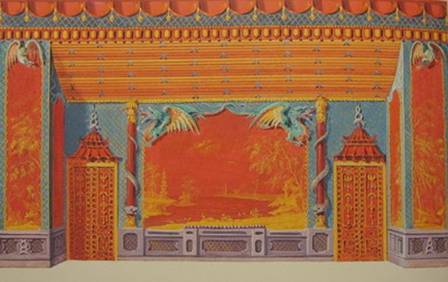
Drawing Room at Middleton Park
Oxfordshire, England, 1839 William Alfred Delamotte
The walls in the living room are all decorated with hand-painted Chinese wallpaper. The birdcage chandelier is interesting. Exotic bamboo furniture and Biedermeier furniture co-exist harmoniously.

Design for the South Wall of the Music Room, Royal Pavilion, London, ca.1817
Frederick Crace. Dragon, pagoda, bamboo and other elements evoke an exotic ambiance.
This popularity was inseparable with the social background. In the 17th to 19th centuries, merchant ships filled with Chinese porcelain, furniture, textiles and other Chinese goods continued to sail to the West. Businessmen, diplomats and missionaries repeatedly introduced Chinese culture. The exotic refreshed the Europeans and the royal class was the first to highly praise Chinoiserie. Chinese style seemed to “open a door of pleasure and happiness."
Today, Chinoiserie can also be identified in European sites such as the Porcelain Cabinet at Berlin’s Charlottenburg Palace, the Chinese pagoda at Kew Gardens in Britain, and the Oval Chinese Cabinet at Schonbrunn Palace in Vienna.
This exotic style was not only a fad in the past, but is now being used in a more flexible, imaginative and modern ways by western designers in the globalized world. In the furnishing markets in Europe, traditional and modern "New Chinese style" design products hold the limelight.
Noted contemporary British designer Kelly Hoppen, who redecorated the homes of Prince William and his wife, the Duchess of Cambridge and David and Victoria Beckham, created a very good blend of Eastern and Western design elements.
Many people of different ages yearn for the exotic. That’s why the French poet Rimbaud said, "Life is elsewhere" and began roaming the world. Through the exotic interior, a lot of people arrived elsewhere in their illusions.
The exhibition runs until March 2. 9 am-5 pm, closed on Mondays. World Art Museum, China Millennium Monument, 9A Fuxing Lu (Road), Haidian district, Beijing. 010-5980-2222.
By Wen Yi
we recommend:
